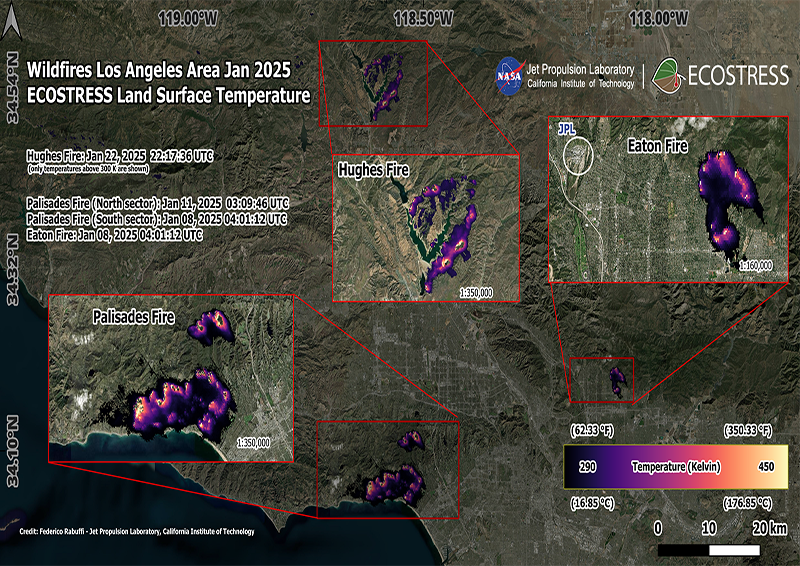Welcome to ECOSTRESS
Save the Date:
ECOSTRESS Science and Applications Team Meeting - Sept 16 - 18, 2025 will be hybrid.
International Workshop on High-Resolution Thermal Earth Observations, November 18 - 20, 2025 in Toulouse, France
News Flash: ECOSTRESS has received approval for operations through FY2026 with potential continued operations until FY2029, subject to a successful 2026 Senior Review!
News Flash: ECOSTRESS has now acquired over 540,000 scenes (after In Orbit Checkout)
ECOSTRESS acquires high resolution temperature and emissivity (composition) images of the Earth's surface. These are used for a variety of applications including:
- Determining how much water to put on fields for maximum crop with minimum water use
- Mapping wildfires and volcanic hazards
- Improving urban development and infrastructure
- Discovering critical mineral resources
Plants regulate their temperature by releasing water through tiny pores on their leaves called stomata. If they have sufficient water they can maintain their temperature, but if there is insufficient water, their temperatures rise and this temperature rise can be measured with ECOSTRESS. The images acquired by ECOSTRESS are the most detailed temperature images of the surface ever acquired from space and can be used to measure the temperature of an individual farmers field.
One of the core products that will be produced by ECOSTRESS team is the Evaporative Stress Index (ESI). ESI is a leading drought indicator - it can indicate that plants are stressed and that a drought is likely to occur providing the option for decision makers to take action.
NASA's ECOSTRESS Maps Los Angeles County Wildfires

Los Angeles County has faced three major wildfires this month. The Palisades Fire, which started on January 7, 2025, near Pacific Palisades, burned 23,448 acres, destroyed 6,837 structures, and caused 12 civilian fatalities. On the same day, the Eaton Fire ignited in the Altadena/Pasadena area, devastating 14,021 acres and 9,418 structures, with a tragic toll of 17 civilian deaths. Later, on January 22, 2025, the Hughes Fire broke out near Lake Hughes Road and Castaic Lake, burning 10,396 acres (according to CAL FIRE, as of January 28, 2025).
Land Surface Temperature (LST) products from NASA's ECOsystem Spaceborne Thermal Radiometer Experiment on Space Station (ECOSTRESS) have clearly identified these fires. Data collected by the ECOSTRESS sensor and shown on the map include the Hughes Fire on January 22, 2025, at 2:17:36 PM PST (22:17:36 UTC), the northern sector of the Palisades Fire on January 10, 2025, at 7:09:46 PM PST (January 11, 2025, 03:09:46 UTC), the southern sector of the Palisades Fire on January 7, 2025, at 8:01:12 PM PST (January 8, 2025, 04:01:12 UTC), and the Eaton Fire on January 7, 2025, at 8:01:12 PM PST (January 8, 2025, 04:01:12 UTC). The temperature data, shown on a black – purple – yellow color ramp, represent values ranging from 290 K (16.85°C / 62.33°F) to 450 K (176.85°C / 350.33°F), providing critical insights into fire intensity and spread.
More About the Mission
JPL built and manages the ECOSTRESS mission for the Earth Science Division in the Science Mission Directorate at NASA Headquarters in Washington. ECOSTRESS is an Earth Venture Instrument mission; the program is managed by NASA's Earth System Science Pathfinder program at NASA's Langley Research Center in Hampton, Virginia.
Credit: NASA/JPL-Caltech
News Media Contacts
Jane J. Lee / Andrew Wang
Jet Propulsion Laboratory, Pasadena, California
818-354-0307 / 626-379-6874
jane.j.lee@jpl.nasa.gov / andrew.wang@jpl.nasa.gov
Written by Sally Younger